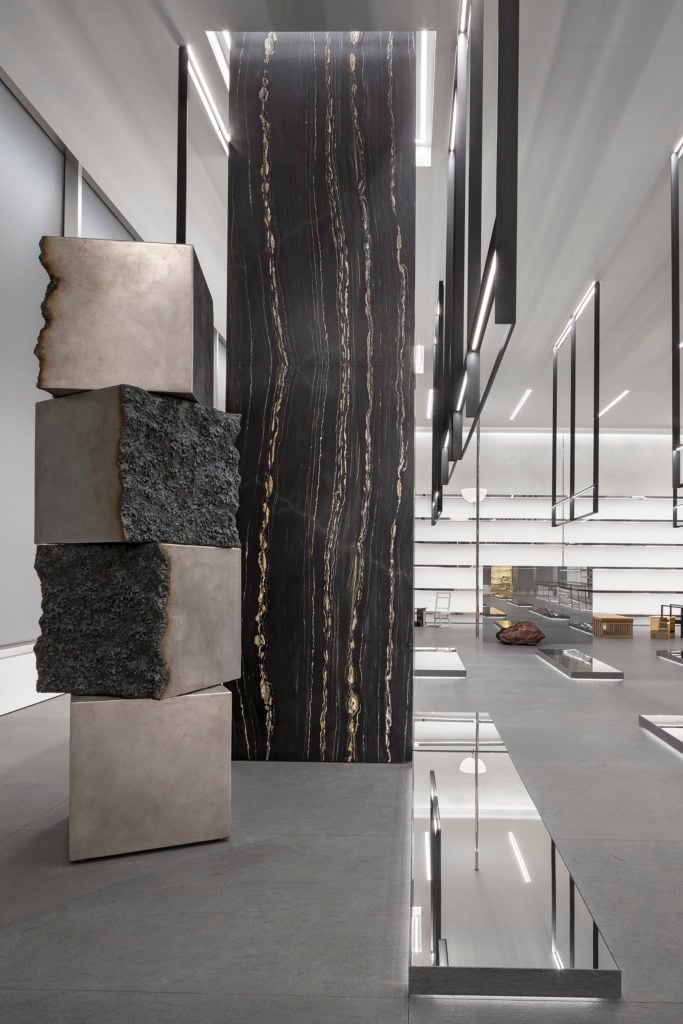Art World
How One Sculptor Optimizes the ‘Constructive Potential’ of a Steel-Industry Byproduct
James Balmforth uses a thermic lance—a torch-like tool that can burn at 7,000 degrees—to create his work.

James Balmforth uses a thermic lance—a torch-like tool that can burn at 7,000 degrees—to create his work.

Tanner West

Visitors to Celine’s Madison Avenue location this spring will find among the luxurious materials built into the design of the flagship—volcanic rock in the floors, imported marble on the walls, and fur and leather on the racks—a seemingly renegade work of art among all the high design.
A column of steel cubes, titled Surface Response (Stack), a 2019 commission from artist James Balmforth, towers over the store’s south side, standing some eight-and-a-half-feet tall. Surrounded by specially designed furniture by Celine’s creative director, Hedi Slimane, each cube bears the marks of a torch that, in the artist’s hands, has heated the steel and left one entire face of each block darkened, as if caught in mid-boil. The steel is considered useless in industry, where it is known as slag, but Balmforth aims to exploit it for its expressive power—and in fact, a tense conversation emerges between the still, gray, semi-glossy steel and the blackened matte slag.
‘It certainly looks like a lush environment, lots of highly labored, value-laden surfaces which are hard not to be drawn to,” the London-based Balmforth says of the flagship. “I don’t always find what I make aesthetically pleasing in a conventional sense. But this lack is substituted by a methodological appeal, how it was made, the processes that led to it and what the things I learned [in the making]. So maybe it is just my perspective, but the sculpture appears to stand in contrast to its surroundings, like some kind of counter-ornamentation to the beauty and embellishment that surrounds it.”
Surface Response (Stack) is just one of the artist’s recent sculptures that he made using a thermal lance, a torch-like tool that burns at temperatures north of 7,000 degrees, putting the work in conversation with the volcanic rock, another result of inconceivably high temperatures. The thermic lance can burn concrete and steel, and is often used to demolish industrial structures. A video online shows the artist torching a column of aluminum to create a similar work, Boundary Interface (2018), on the grounds of the Cass Sculpture Foundation, in West Sussex, England.
“The processes used on this work cause the steel to melt,” Balmforth says of Surface Response (Stack). “When transitioning from a frozen state to a molten state, the metal crosses a boundary, known as a phase boundary, whereby it undergoes internal structural transformations. The material becomes more volatile and more reactive, activating a material expressivity that enables previously hidden qualities and characteristics to surface.”
While giant steel bridges, ships, and heavy machinery represent the triumphs of the industrial age, the dramatic demolition of metal and stone via Balmforth’s torch symbolizes progress of a different sort—creation through destruction. Other works by the artist, such as Failed Obelisk (a 1999 sculpture that clearly nods to Barnett Newman’s 1963–67 Broken Obelisk) is a monument to ruinous forces.
“The thermic lance was developed as an effective hand held demolition tool,” Balmforth says. “But aside from my interest in the underlying chemistry, I wanted to try to use what is an inherently destructive tool in a different way, to subvert its intended function and to foreground its constructive potential.”